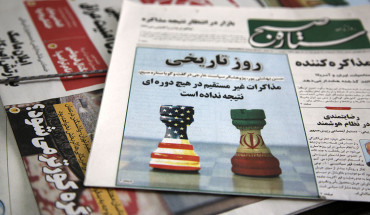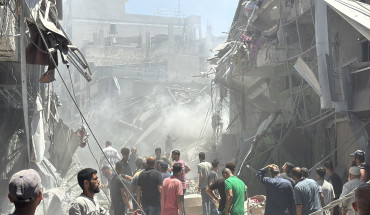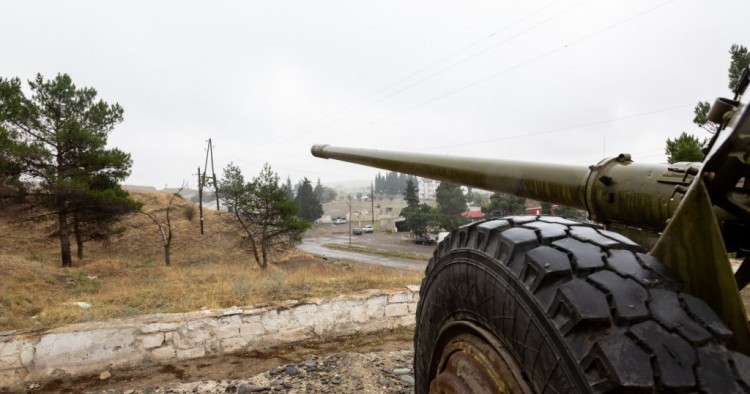The renewed military conflict in Nagorno-Karabakh between Azerbaijan and Armenia threatens geopolitical stability in the wider Black Sea-Caspian region, and has the potential to evolve into greater regional escalation, involving major regional powers Turkey, Russia, and Iran. The scale of military operations, and range of heavy military equipment involved, is increasing risks for major energy and transportation infrastructure, which connect Caspian oil and natural gas fields in Azerbaijan to major energy markets in Turkey, the Mediterranean, and different parts of Europe.
It is true that oil and gas pipelines are further north from the current military conflict area, and that the pipelines are buried in the ground and thus are not an easy target. But it is also true that they can be reached by heavy artillery and missile fire by accident, if not deliberately. Azerbaijan has already claimed that a cluster bomb landed near a pipeline on October 6. Armenia has several times denied any claims of targeting international energy infrastructure.
Responding to questions about the security of oil and gas pipelines, and whether Azerbaijan needs international assistance to ensure their safety, Assistant to the President of Azerbaijan Hikmat Hajiyev stated that Azerbaijan does not see the need for any third party to participate in ensuring the safety of oil pipelines. But it is clear the security of pipelines is an issue of concern.
What is at stake?
Energy, as well as general transit and transportation, are important contexts of the current escalation of the Nagorno-Karabakh conflict.
Currently, the key transit energy infrastructure elements with international significance include two oil pipelines connecting oil-producing fields in the Azerbaijani section of the Caspian Sea to the Georgian Black Sea port of Supsa and the Turkish Mediterranean port of Ceyhan: the smaller, 100,000 barrel per day capacity Baku-Supsa pipeline, and the larger, million-barrel capacity Baku-Tbilisi-Ceyhan (BTC) pipeline. At present, around 700,000 barrels of oil flows through these two pipelines, supplying crude oil to Turkish, Israeli, and other Mediterranean refineries. The BTC pipeline currently carries mainly crude oil from ACG fields and Shah Deniz condensate from the Azerbaijani section of the Caspian Sea. In addition, other volumes of crude oil and condensate continue to be transported via BTC, including from Turkmenistan, Russia, and Kazakhstan.
Another important infrastructure network of international significance is the so-called South Caucasus Gas Pipeline, also known as the Baku-Tbilisi-Erzurum natural gas pipeline. It started with the production of 8 billion cubic meters (bcm) of natural gas annually at the Shah-Deniz field near Baku. Since 2007, it has been used to export gas to Georgia and Turkey. This pipeline, and the natural gas from the Shah-Deniz field, has provided Georgia with a much-needed alternative to Russian natural gas supplies, and has helped Turkey to diversify its supplies as well. This pipeline became a basis for the larger pipeline system crossing six countries: the Sothern Gas Corridor (SGC). This $45 billion project – the largest energy project in the world between 2014 and 2020 – allowed production of an additional 16 bcm per year. The largest recipient of the gas will be Italy. The system of pipelines has linked an upgraded South Caucasus Pipeline to the Trans-Anatolian Pipeline (TANAP) in Turkey, which is already bringing Azerbaijani gas to the western border of Turkey. The first supply of gas reached TANAP in Turkey in 2018. From there, natural gas will be directed to European markets via the Trans Adriatic Pipeline (TAP), which stretches between Greece, Albania, and Italy. Initially, 10 bcm of natural gas will be exported through TAP each year, but capacity can be increased to 20 bcm. For comparison, Russia, the main supplier of natural gas to the EU, plans to export 170 bcm to Europe in 2020.
The Southern Gas Corridor will be fully operational by the end of 2020, directly connecting natural gas fields in the Caspian to EU markets for the first time. Although initial volumes will cover only about two percent of total European demand, the project has the potential to expand substantially based on increased volumes from other fields in both Azerbaijan and Turkmenistan.
The picture is different for the Turkish market. Russia has traditionally dominated the Turkish natural gas market since the 1990’s. In 2018, Russia sold 24 bcm of natural gas to Turkey, making it one of the most significant markets for Russia’s Gazprom. Two major pipelines directly connect Russia to Turkey via the Black Sea. The Blue Stream Pipeline with the capacity of 16 bcm was commissioned in 2005. The Turkstream pipeline has a capacity of 31.5 bcm annually and began supplying gas to Turkey in January 2020. These two pipelines allow Russia to bypass Ukraine for its supplies to Turkey, Bulgaria, and other markets in Southern Europe, and serve not only commercial, but also major geopolitical objectives of Russia aimed at increasing dependency on Russian gas in Turkey and the Balkans.
On the other hand, the Southern Gas Corridor has allowed Turkey to buy more Azerbaijani gas at a better price. Turkey received more than 6 bcm of Azerbaijani gas between January and July of 2020, an increase of 24 percent compared to the same period last year. Turkey has contracts to purchase more than 12 bcm from Azerbaijan, and transit infrastructure crossing Azerbaijan and Georgia allows Turkey to receive these volumes of gas with no geopolitical strings attached. These realities led to a major drop of Russian gas sales to Turkey. Turkey is also buying more LNG from the United States and other sources, allowing major diversification from dependency on Russia. During the first quarter of 2020, Gazprom’s share on Turkish market dropped below 10 percent, compared to 33 percent in March 2019.
To fully understand the energy context of the current conflict, it is important to also mention that development of pipeline projects connecting Azerbaijan to world markets became possible with major political and diplomatic support from the United States. For more than two decades, the United States has invested significant political and financial resources in the process of strengthening the political and economic sovereignty of countries of the Caspian. This effort facilitated the development of vibrant trade and transit between the Caspian region and the Black Sea and Eastern Mediterranean. Resource-rich Azerbaijan, Kazakhstan, and Turkmenistan, as well as transit and consumer countries like Georgia and Turkey, are the major beneficiaries of the functioning and expanding pipeline, railway, highway, and port infrastructure. Turkey acted as a close ally and partner, working closely with the United States to enhance cooperation between regional countries, improving regional connectivity, as well as the region’s connectivity to the rest of the world.
The conflict with Azerbaijan over Nagorno-Karabakh prevented Armenia from being a part of these major international developments. A peaceful resolution of the conflict would mean major political and economic benefits to all parties involved, and first and foremost, to Armenia.
Trajectories of potential development
A prolonged military conflict cannot be in the interests of Armenia or Azerbaijan. Human lives are lost on both sides, economic resources are exhausted, and prospects of economic recovery from the crisis caused by the pandemic look even gloomier. Both sides understand this reality. Strong diplomatic intervention and mediation is necessary to bring the conflicting sides to terms of agreement. The so-called Minsk Group of the OSCE, Russian Minister of Foreign Affairs Sergei Lavrov, and US Secretary of State Mike Pompeo have all tried, so far without success, to mediate a ceasefire.
The Minsk Group of the OSCE, as well as Russia – as Armenia’s treaty-bound major military ally – traditionally play major diplomatic roles in the conflict. These efforts have not brought a lasting resolution, as we can see with the current escalation. A new element to the conflict is the significantly more pro-active role of Turkey in the Black Sea region and the South Caucasus. Turkey is clearly trying to play a larger diplomatic role in the Minsk Group format, where it is a member but not Co-Chair (unlike Russia, France, and the United States). Even more importantly, Turkey is taking an active role in partnership with Ukraine, while at the same time enhancing support to Georgia’s NATO membership. Very active military and diplomatic support to Azerbaijan is part of a new Turkish strategy in the region. We still have to see if there will be strong Russian push-back to this new strategy, but Russian energy interests in the Turkish market may have an impact on the scale of the Russian response.
So far, Russia’s response to the escalation of conflict is a major puzzle for observers. Some, in our opinion naively, assume Russia no longer has the bandwidth to intervene and impact the two sides. Looking in depth to the realities of the conflict, Russia is probably the only party that will benefit from a prolonged conflict from both an energy and geopolitical perspective. Potential military success of Azerbaijan weakens Armenia and its more reform-minded leadership, headed by Prime Minister Nikol Pashinyan, who came to power through one of President Vladimir Putin’s much-despised color revolutions. To the extent that an Armenian leader can be anti-Russian, Pashinyan is perceived as anti-Russian and relatively more Western leaning compared to his predecessors. Reminding him of Russia’s role in Armenia’s security interests seems to be one explanation of the limited and slow Russian response to the conflict.
In contrast, Azerbaijan President Ilham Aliyev has never openly challenged Russia. Azerbaijan does not seek membership in NATO or the EU, does not challenge the leadership style of President Putin through democratic rhetoric, and maintains a strategic partnership with Russia as well. Russia could not ignore the careful approach of President Aliyev toward Russia and personally toward President Putin. Russia and Putin are mindful about perceptions. This understanding was reflected in President Putin’s statement on October 22 at the meeting of the Valdai Discussion Club, which probably surprised some observers, but reflects the balanced approach Russia tries to maintain on the surface, at least for now: “Russia sees Armenia and Azerbaijan as its equal partners, it has always had special ties with both countries.”
One irritant in Russian-Azerbaijani relations may be Azeri natural gas sales to Turkey and European markets. But the current conflict gives Russia significant benefits. Close proximity to the pipeline infrastructure increases risk perceptions about the stability of supply and does not serve interests of the energy producers and consumers. Prolonged conflict, or the perception of conflict, will therefore serve Russian interests in energy markets.
While Azerbaijan has made significant military advancements on the territories occupied by Armenian forces outside of Nagorno-Karabakh, full military victory seems unrealistic. For Azerbaijan, military victory would mean full control over not only the seven regions outside of Nagorno-Karabakh, occupied by Armenian forces since 1994, but also full control over Nagorno-Karabakh proper. It is hard to imagine Russia will allow this to happen. If this assumption is correct, even significant military gains cannot lead to full Azerbaijani control over Nagorno-Karabakh, meaning military forces of parties in conflict will continue to face each other with constant threat of escalation. Under those conditions, it would be impossible to stabilize the situation any time soon. The alternative is peacekeeping forces on the lines of separation, but this issue will be very hard to negotiate both in terms of the composition of forces, as well as lines of separation.
And finally, on the potential for a direct military clash between Russia and Turkey over this conflict – Russia and Turkey are not interested. This is not a guarantee of the prevention of a conflict, but it is important that Russia and Turkey have learned how to de-escalate difficult situations over the last several years in Syria and Libya. Whatever short terms political goals President Erdogan may have, Turkey, unlike Russia, is not interested in a prolonged conflict for both strategic and energy security reasons.
Meanwhile, Georgia is a neighbor to all four major countries involved in the conflict (Armenia, Azerbaijan, Russia and Turkey) and maintains close relationships with all but Russia, which invaded Georgia in 2008 and continues to maintain control over 20 percent of Georgian territory. Georgia is interested in the stability in the region; stability and predictability are essential for the Georgian economy. Georgia has large Armenian and Azerbaijani minority populations living in close proximity from each other, while Azerbaijani natural gas supplies have allowed Georgia to eliminate energy dependency on Russia and provided much needed energy security. A regional leader in terms of reform and openness, Georgia also serves as a major transit artery for the wider Black Sea-Caspian region. For these reasons, Georgia maintains neutrality in the conflict and has offered mediation between conflicting parties.
As of October 28, mediation efforts have failed to bring tangible results, and so military escalation continues. It appears that the South Caucasus will be increasingly unstable in the years to come because of this conflict, unless all parties agree to a long-term solution, something difficult to achieve.
Dr. Mamuka Tsereteli is a non-resident scholar with MEI's Frontier Europe Initiative and a Senior Fellow at Central Asia-Caucasus Institute at American Foreign Policy Council. The views expressed here are his own.
Photo by Dominika Zarzycka/NurPhoto via Getty Images
The Middle East Institute (MEI) is an independent, non-partisan, non-for-profit, educational organization. It does not engage in advocacy and its scholars’ opinions are their own. MEI welcomes financial donations, but retains sole editorial control over its work and its publications reflect only the authors’ views. For a listing of MEI donors, please click here.













